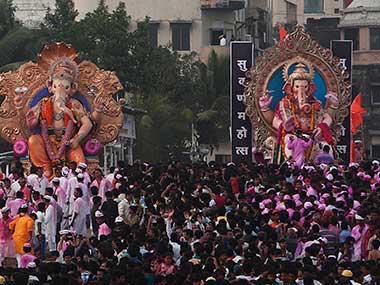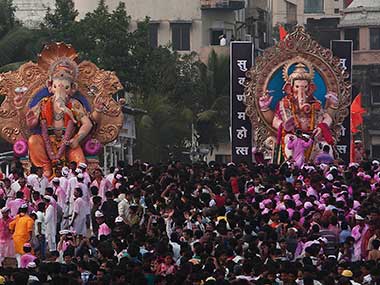Worli Naka, Girgaum Chowpatty and Opera House had the noisest Ganesh visarjans in the city — they also contributed to making this year’s Ganeshotsav the noisiest in seven years. On Wednesday, the 10th day of the Ganpati festival, the noise readings taken by the non-profit organistaion Awaaz Foundation found the levels to be at an all-time high of 123.2 decibels (dB) — way above last year’s highest reading of 121.4 dB (the sound made by thunder or a diesel engine room, classified as being deafening), according to a report in the Hindustan Times. Traditional instruments including cymbals, drums, the tasha — a metal hammer beaten on a metallic plate — and disc jockeys (DJs) were the main causes for noise pollution norms to be flouted. [caption id=“attachment_1122961” align=“alignleft” width=“380”]  Activists said though there seemed to be fewer processions this year, the noise levels, aided by technology, rose higher than the previous years. Reuters[/caption] The Economic Times, said that the levels on Wednesday were the highest in seven years — peaking at 123db in Worli Naka. The permissible limit of noise is 45db for residential areas at night. This year’s worst affected areas included Worli, Lamington Road, Prabhadevi, Pedder Road and Juhu Tara Road. Activists said though there seemed to be fewer processions this year, the noise levels, aided by technology, rose higher than the previous years. “In terms of numbers, there appeared to be fewer processions . Also, the police implemented the deadline on celebrations very well. However, the noise levels didn’t come down,” Sumaira Abdulali, convener , Awaaz Foundation, told the Economic Times. According to HT, noise pollution rules were flouted in almost every part of the city, with Awaaz Foundation recording noise levels above 100dB at eight different places.
Worli Naka, Girgaum Chowpatty and Opera House had the noisest Ganesh visarjans in the city — they also contributed to making this year’s Ganeshotsav the noisiest in seven years.
Advertisement
End of Article


)
)
)
)
)
)
)
)
)



